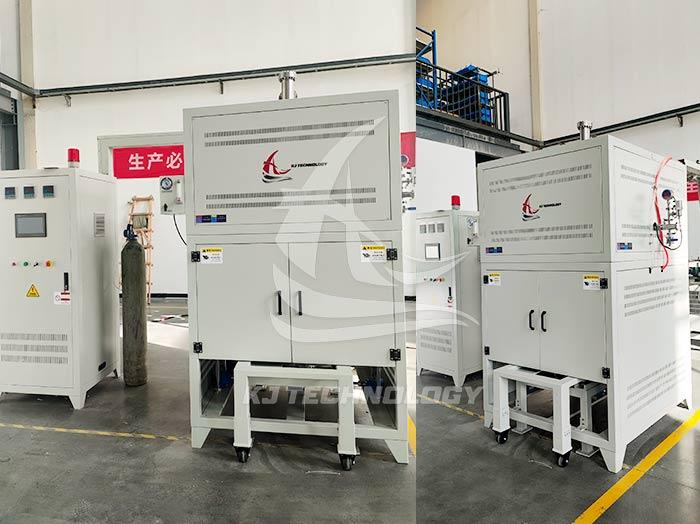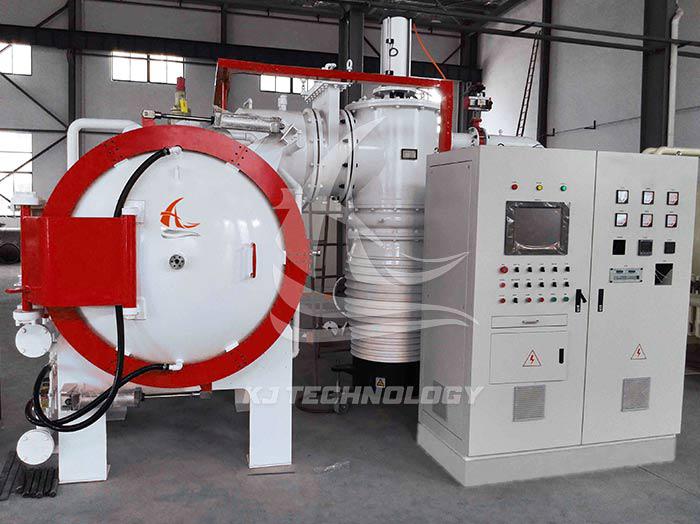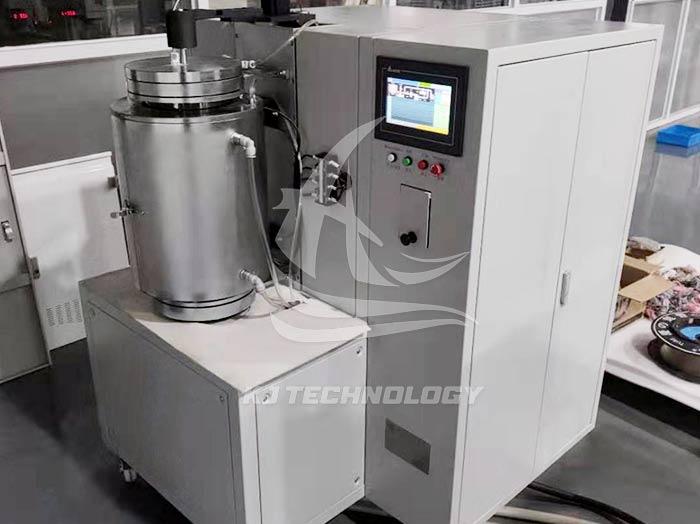high vacuum furnace
 07-25-2025 Author: KJ technology
07-25-2025 Author: KJ technology
A high vacuum furnace is an industrial equipment used for heating materials in extremely high vacuum environments (usually with a vacuum degree of 10 ⁻³ Pa to 10 ⁻⁵ Pa). It is widely used in fields such as materials science, metallurgy, ceramics, semiconductor manufacturing, and scientific research experiments. The following provides a detailed introduction from five aspects: working principle, core components, technical advantages, application scenarios, and operational precautions:
1. Working principle
A high vacuum furnace extracts gas from the furnace chamber through a vacuum system (consisting of a vacuum pump, vacuum valve, vacuum measuring device, etc.), creating a low-pressure environment to prevent chemical reactions such as oxidation and decarburization of materials during heating. In a vacuum state, heat transfer is mainly carried out through radiation. Heating elements (such as resistance wires, graphite, molybdenum wires, etc.) convert electrical energy into thermal energy and radiate it to the workpiece in the form of electromagnetic waves, achieving uniform heating.
2. Core components
Furnace body: Made of advanced refractory materials such as ceramic fibers, graphite, molybdenum foil, etc., to ensure stability and durability at high temperatures.
Vacuum system: including mechanical pumps, diffusion pumps, Roots pumps, etc., can achieve high vacuum degree (up to 7 × 10 ⁻ ³ Pa), meeting the requirements of precision machining.
Heating system: using resistance wires, silicon carbide rods, graphite, induction coils, etc. as heating elements, with a temperature range covering 750 ℃ to 3000 ℃, suitable for different material treatments.
Temperature control system: Equipped with high-precision temperature sensors and controllers, it can accurately adjust the furnace temperature to ensure experimental accuracy.
Water cooling system: protects the furnace body and vacuum system from high temperature damage.
3. Technical advantages
Non oxidizing environment: prevents material oxidation during heating, maintains surface cleanliness, and improves material performance.
Accurate temperature control: The temperature control accuracy can reach ± 1 ℃, meeting the high-precision heat treatment requirements.
Uniform heating: Radiation heat transfer method reduces internal thermal stress of materials, avoiding defects such as cracking and deformation.
Reduce pollution: The vacuum environment isolates external pollutants (such as dust and moisture) to ensure the purity of the workpiece.
Energy saving and efficient: High thermal efficiency, significantly lower energy consumption than traditional furnace types.
Wide applicability: It can handle various materials such as metals, ceramics, and composite materials, and supports processes such as sintering, melting, brazing, and annealing.
4. Application scenarios
Metal heat treatment: such as vacuum quenching, tempering, annealing, to improve the mechanical properties of metals (hardness, toughness, fatigue resistance).
Vacuum brazing: Connecting metal components under vacuum conditions to avoid the formation of oxides and obtain a strong weld seam.
Powder metallurgy: Vacuum sintering of metal powders to prepare dense parts such as gears and cutting tools.
Semiconductor manufacturing: used for processes such as chip annealing, doping, and deposition to improve chip performance.
Ceramic processing: Sintering ceramic products to avoid bubbles or oxidation and improve product quality.
Research experiment: Provide controllable vacuum heating environment for materials science, physics, chemistry and other fields, and support the development of new materials.
5. Operation precautions
security check:
Ensure that there are no flammable or explosive materials around the furnace and keep the environment clean.
Check whether the electrical circuit and grounding are reliable to prevent leakage.
Confirm that the vacuum pump, vacuum gauge, and other components are working properly, and that the vacuum pipeline is unobstructed.
Material preparation:
The materials to be processed need to be cleaned and dried to prevent moisture and dirt from entering the furnace.
Operating standards:
Familiar with equipment operation buttons and functions, start the vacuum system, set temperature and time according to regulations.
Monitor the temperature, vacuum level, and equipment operation status inside the furnace, and promptly handle any abnormalities found.
Maintenance and upkeep:
After sintering or processing, clean the interior and surrounding residues of the furnace after the equipment cools down.
Regularly inspect the cooling water system to prevent mineral deposition and blockage.
Replace vulnerable parts such as heating elements and sealing rings to extend equipment lifespan.
Emergency Management:
In case of unexpected situations such as power outages or water outages, immediate emergency measures should be taken (such as opening backup water sources) to ensure the safety of equipment and personnel.








